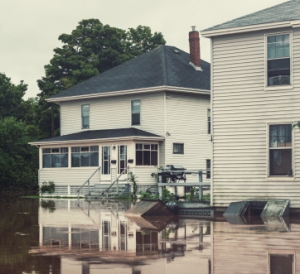|
March 3-9 is National Severe Weather Preparedness Week, and as we move from winter into spring, spring rains coupled with melting snow and ice can increase the risks of flooding, and it’s not just those in high risk flood zones who are vulnerable. Here’s some information on evaluating your flood risk and how you can protect your home with flood insurance.
Floods are often associated with rivers and streams overrunning their banks, or with heavy rains from hurricanes and other major storms, and while those are very real hazards, the reality is that flooding can be caused by a number of factors.

Is it getting warm or is it me?
During the days of spring where it can suddenly get very warm out, the ground may still be frozen, and so if the ground cannot absorb the water, melting snow can cause flooding issues for homes and businesses. As it gradually becomes warmer, though and the ground is able to
absorb the water from melting snow and springtime rain, eventually it may become saturated, and with nowhere else to go, water could still accumulate on your property. All of the melting snow and spring rain can also cause the rapid accumulation of debris in storm drains, as leaves, sticks and gravel that had been buried under snow for several months are all of a sudden exposed and carried into the drainage system. If those storm drains are blocked, the water from just a single rainstorm can find its way to your property. When the water has nowhere else to go it can begin to come into basements and ground floors of homes and businesses. The other major risk comes from intense periods of heavy rain, where the rainfall comes down faster than it can be absorbed into the ground, something that can easily happen almost anywhere in the country.
What are your flood risks?
The first step in flood safety is to know the risks, and this involves finding out what type of flooding you may be vulnerable to. If your home is near the coast or a body of water that could spill over its banks, or if you live in a low lying area or valley, you may be in a high risk flood zone. You can check flood hazard maps, created by the Federal Emergency Management Agency (FEMA), which can show you whether you live in one of these high risk areas and where your risk comes from. But even if you’re not in a high risk zone, you’re not immune to the potential for flooding, as heavy rains can fall almost everywhere, and if the ground cannot absorb it, the water has to go somewhere. According to FloodSmart.gov, 20% of all flood insurance claims come from areas that are not designated as high risk.
Another factor to consider when evaluating your risk of flooding is development and new construction in your area. A development project or new construction can drastically alter how the ground in the area is able to absorb water from rain or melting snow, particularly when the ground around the project is cleared of trees and other brush that help absorb ground water, or if the project has large paved areas, like parking lots, that could impact drainage and run-off. This could be true whether it’s a relatively small project like a new home being built next door to something much larger, like a shopping center, which may be large enough to impact flood risk for an entire neighborhood.
Flood Insurance
Unfortunately, many people may not know that flood damage is not covered by homeowners insurance. Three major threats—fire, lightning and windstorms—are traditionally covered by homeowners property insurance. Flooding is excluded from homeowners coverage, as flood risk is very widespread and impacts all 50 states. In fact, in high risk areas, the risk of a home being damaged by a flood is twice that of it being damaged by a fire, according to FloodSmart.gov. Private insurers are not able to absorb all that risk.
The National Flood Insurance Program (NFIP) is part of FEMA. It provides flood coverage to homeowners and renters as well as commercial building owners in communities that have joined NFIP, which requires they take certain steps to help prevent flooding. Coverage is provided through Trusted Choice® independent insurance agents, as well as through other insurance agents.
Flood insurance may not just be desirable for homeowners, it may be required. For example, mortgage lenders are legally bound to require consumers buying a house in a high-risk flood zone to have flood insurance.
If you own or rent property in low- or moderate-risk flood areas, you can buy flood insurance, and may be eligible for a lower-cost preferred risk flood policy. Unlike homeowners insurance, flood insurance typically has a waiting period. The NFIP sets a standard 30-day waiting period before flood coverage goes into effect, though it’s important to discuss this with your insurance agent to understand what the exceptions to the waiting period are and whether the waiting period would apply to your specific situation.
A Trusted Choice® independent insurance agent can help you sort out the coverage you need, what the policy will and won’t cover and can help you get it through the NFIP.
Posted Thursday, March 21 2013 9:08 AM
|